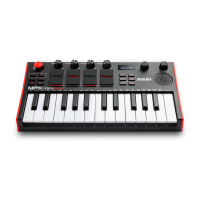6
18. Resonance/Release: This assignable 270º knob sends a MIDI CC message and can be
switched to its secondary function using the Knob Bank A/B button. When the Knob
Bank A/B button is set to Bank A, adjust this knob to change the Resonance setting for
the internal sounds. When the Knob Bank A/B button is set to Bank B, adjust this knob to
change the Release setting for the internal sounds. In USB mode, adjust this knob to
send assignable MIDI CC messages.
19. Reverb Amount/EQ Low: This assignable 270º knob sends a MIDI CC message and can
be switched to its secondary function using the Knob Bank A/B button. When the Knob
Bank A/B button is set to Bank A, adjust this knob to change the amount of the Reverb
effect for the internal sounds. When the Knob Bank A/B button is set to Bank B, adjust
this knob to change the low band EQ setting for the internal sounds. In USB mode, adjust
this knob to send assignable MIDI CC messages.
20. Chorus Amount/EQ High: This assignable 270º knob sends a MIDI CC message and
can be switched to its secondary function using the Knob Bank A/B button. When the
Knob Bank A/B button is set to Bank A, adjust this knob to change the amount of the
Chorus effect setting for the internal sounds. When the Knob Bank A/B button is set to
Bank B, adjust this knob to change the high band EQ setting for the internal sounds. In
USB mode, adjust this knob to send assignable MIDI CC messages.
21. Volume: Controls the internal sounds volume sent to the internal speaker and the
Headphone Output.
22. Speaker: Hear the internal sounds that are played with the keys and pads from here.
Note: The internal speaker is disabled when the headphone output is used.
Rear Panel
123 4
1. Power Switch: Adjust this switch to the appropriate position when powering the unit
through a USB connection or with batteries. When set to USB, with no cable connected,
this button will turn off your MPK mini Play mk3 to save battery life.
2. USB Port: The USB port delivers power to the keyboard and transmits MIDI data when
connected to a computer to trigger a software synth or MIDI sequencer.
3. Headphone Output: Connect headphones here to listen to the internal sounds triggered
with the keys and pads. You can also connect MPK mini Play mk3 to speakers using an
1/8” adapter.
Note: Connecting this output will disable the internal speaker.
4. Sustain Input: This socket accepts a momentary-contact foot pedal (sold separately).
When pressed, this pedal will sustain the sound you are playing without having to keep
your fingers pressed down on the keys.
Bottom Panel (not shown)
1. Battery Compartment: Install 4 AA alkaline batteries here to power the unit if not being
powered through a USB connection.

